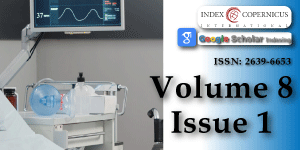Dalbavancin and moleculight in the COVID-19 pandemic
Main Article Content
Abstract
The COVID-19 Pandemic, which began in March 2020, and its associated surges, had an immense impact on our medical staff and their ability to perform their daily duties.
The COVID-19 Pandemic necessitated hospital modifications, including the expansion of the Emergency Department, ICU, and Isolation units. The overwhelmed staff and overburdened ER and ICU required adjustments to deal with the Inpatient impasse. For example, temporary patient care rooms needed to be set up for the overflow of patients. The tsunami of the Pandemic almost overwhelmed our hospital.
With the challenges presented to our hospital during the Pandemic, we needed a fresh perspective to our multi-disciplinary approach. Thus, we fathomed that the use and cost-effectiveness of both Dalbavancin, a long-acting lipoglycopeptide antibiotic combined with the diagnostic Moleculight Imaging Device would be a sound decision.
We hypothesized that with the use of this cost-effective antibiotic in conjunction with the use of the Moleculight Imaging Device, with its fluorescent imaging, we could detect the presence of bacteria and assist our wound treatment and decision-making.
A shift in patients from the Emergency Room/Inpatient Department to the Outpatient Department/Wound Care Center was made possible with the use of these two novel products.
Article Details
Copyright (c) 2023 Caputo WJ, et al.

This work is licensed under a Creative Commons Attribution 4.0 International License.
Bolton L. Improving venous ulcer outcomes. Wounds. 2022 Apr;34(4):116-118. doi: 10.25270/wnds/2022.116118. PMID: 35452410.
Ramsey SD, Newton K, Blough D, McCulloch DK, Sandhu N, Reiber GE, Wagner EH. Incidence, outcomes, and cost of foot ulcers in patients with diabetes. Diabetes Care. 1999 Mar;22(3):382-7. doi: 10.2337/diacare.22.3.382. PMID: 10097914.
Tennvall GR, Apelqvist J, Eneroth M. Costs of deep foot infections in patients with diabetes mellitus. Pharmacoeconomics. 2000 Sep;18(3):225-38. doi: 10.2165/00019053-200018030-00003. PMID: 11147390.
Reiber GE. Epidemiology of foot ulcers and amputations in the diabetic foot. In: Bowker JH, Pfeifer MA, Eds. The Diabetic Foot. St. Louis MO: Mosby; 2001. 13-32.
Fleisher LA, Schreiber M, Cardo D, Srinivasan A. Health Care Safety during the Pandemic and Beyond - Building a System That Ensures Resilience. N Engl J Med. 2022 Feb 17;386(7):609-611. doi: 10.1056/NEJMp2118285. Epub 2022 Feb 12. PMID: 35148040.
Learish J. The most expensive states for ER visits, ranked. CBS News. 2020; Dec. 4. https://www.cbsnews.com/pictures/emergency- room-visit-cost-most-expensive-states/
Dalvance (Dalbavancin) prescribing information. Duralta Therapeutics. https://www.rxabbvie.com/pdf/dalvance_pi.pdf
Serena TE, Gould L, Ousey K, Kirsner RS. Reliance on Clinical Signs and Symptoms Assessment Leads to Misuse of Antimicrobials: Post hoc Analysis of 350 Chronic Wounds. Adv Wound Care (New Rochelle). 2022 Dec;11(12):639-649. doi: 10.1089/wound.2021.0146. Epub 2021 Dec 3. PMID: 34714159; PMCID: PMC9527054.
The Joint Commission R3 Report Issue 8: New Antibiotic Stewardship Standards. https;//www.jointcommission.org/standard.
Gardner SE, Frantz RA, Doebbeling BN. The validity of the clinical signs and symptoms used to identify localized chronic wound infection. Wound Repair Regen. 2001 May-Jun;9(3):178-86. doi: 10.1046/j.1524-475x.2001.00178.x. PMID: 11472613.
Singh N, Armstrong DG, Lipsky BA. Preventing foot ulcers in patients with diabetes. JAMA. 2005 Jan 12;293(2):217-28. doi: 10.1001/jama.293.2.217. PMID: 15644549.
Heath,S. Patient Satisfaction and HCAHPS: What It Means for Providers. Insights Xtelligent Healthcare Media, May 24, 2016. https:// ptientengagementhit.com/features/patient-satisfaction-and-hcahps-what- it-means-for-providers.

